The Complete Guide To Mesa Arch At Sunrise In Canyonlands National Park (2023)
A complete guide to witnessing and photographing Mesa Arch at sunrise, including trail info, the best time to visit, when to arrive, camera settings, packing list, where to stay, information about Canyonlands National Park and how to get to Mesa Arch, nearby attractions, and additional tips to ensure you have the best possible experience.
Watching the sunrise over the sandstone cliffs, spires, and canyons of Canyonlands National Park as it illuminates the Colorado River and its tributaries while framed by Mesa Arch is not only a photographer’s dream but that of nature lovers, too. Read on to learn everything you need to know about turning this dream into a reality.


Overview Of The Hike To Mesa Arch At Sunrise
Witnessing Mesa Arch at sunrise is quite possibly my favorite sunrise memory of all time. As the sun hits the arch, it illuminates the belly of the arch with a brilliant orange. If there aren’t any clouds in the sky, the arch should stay orange for about an hour or more after the sun rises.
However, don’t take that as an excuse to show up here just after sunrise. You don’t want to miss the magic of the brief moments when the sun beams align directly with the edges of the arch to create an incredible sunburst effect when captured correctly on camera.
Mesa Arch Trail Statistics
- Name of the trailhead: Mesa Arch Trailhead
- Difficulty: Easy
- Distance: 0.6 miles roundtrip
- Elevation gain: 56 – 88 feet, depending on whether you hike clockwise or counter-clockwise
- Time to hike: around 30 minutes roundtrip
- Facilities: small parking lot (about 25 spaces for cars and several for RVs) and a pit toilet at the trailhead
- Handicap accessibility: this trail is not handicap accessible
- Pet policy: pets are not allowed on this trail
The Mesa Arch trail, rated as easy, is a short 0.6-mile (1 km) loop with up to 88 feet of elevation gain. The hike should take an average of 30 minutes roundtrip to complete. However, it is important to note that the trail is uneven and rocky, thus proper footwear like hiking shoes or boots are recommended. If you plan to visit during winter, you might also want to wear ice grips.

After about 15 minutes of walking, you’ll approach the halfway point of the trail at the top of the mesa. This is where you’ll be greeted with a stunning arch on the edge of a cliff with a jaw-dropping view over Buck Canyon and towards the La Sal Mountains in the distance. That, my friends, is the famed Mesa Arch! And while you won’t be able to fully realize the extent of this magnificent view until the sun starts to rise, it won’t be long before you’ll be blown away!
Note: If you want to reduce the number of stairs and elevation gain, walk the trail clockwise to the arch and then retrace your steps.
How To Prepare For Visiting Mesa Arch At Sunrise
Best Time To Visit Mesa Arch At Sunrise In Canyonlands National Park
The most popular times to visit the park are when the weather is most temperate in spring (April through May) and fall (mid-September through October). Therefore, consider visiting outside of these windows for fewer crowds, just be sure to dress accordingly.
The summer heat can be unbearable as it often soars past 100 degrees Fahrenheit and the monsoon season in late summer brings flash flooding. However, Mesa Arch still gets crowded at sunrise during the summer.
While winter can certainly get cold with lows as cold as zero degrees Fahrenheit, the area doesn’t often get much snow. But, be warned, if there is even a small amount of snow or ice, the trails and roads may be impassable, so plan accordingly and consider a 4WD or AWD rental car.
Book your rental car for Moab below through RentalCars.com.
If you do choose to visit during the winter, you may be lucky enough to witness the stunning contrast of white snow against the orange sandstone which will glisten as the sun hits Mesa Arch at sunrise.

My dad and I visited on a weekday in January and actually found it to be the perfect time to witness a sunrise at Mesa Arch because there were only a handful of other people the day we went.
Mesa Arch is the most popular spot for sunrise in the entire park, and thus this particular hike can get rather crowded.
Plan accordingly by following these tips:
- Visit outside of high season.
- Visit on a weekday.
- Arrive at the trailhead early to get a parking spot and stake out your spot in front of the arch. If you are a photographer aiming for the iconic shot, plan to arrive at the trailhead at least 75-90 minutes before sunrise during the off-season to be safe. Increase this to 2-3+ hours during the high season.
- For all the night owls, visiting between October and early March will not only afford you fewer crowds but will also afford you the opportunity for a later wake-up call— a huge win for this non-morning person.
- Pack your patience. No matter what time of year you visit, you are almost certainly guaranteed to have company. Go in expecting to share the space and make the most of your experience by striking up conversations with fellow photographers and visitors before the first light. This is especially helpful if you don’t get a spot right in front of the arch, as your friendliness may earn you brownie points for getting to sneak in sooner for your dream pictures.
When To Arrive To Mesa Arch
The Mesa Arch parking lot is small and fills up quickly. Most photographers arrive about an hour before sunrise.
If you’re dead set on getting the iconic shot, you may want to plan to arrive at the trailhead 75-90 minutes prior to the stated sunrise time to be extra safe if you’re visiting outside of high season.
You may be okay arriving 45-60 minutes ahead of the stated sunrise time, however, it really is a crap shoot for how many others will join in on the fun, and if this is a one-time experience for you, you’re better off setting that alarm a little bit earlier to be on the safe side.
If you’re visiting during high season, you’ll likely need to arrive at least 2-3 hours early to get one of the most coveted spots.
For those just wanting to witness the sunrise, aim to arrive to the trailhead 30 minutes before sunrise to ensure a little buffer time so you’re sure not to miss it.
Things like the weather and day of the week will certainly impact the crowds, so keep those factors in mind.
While the coveted space directly in front of the 27-foot-long arch is small and fills up quickly, there are many other great sunrise-viewing vantage points in the immediate vicinity.

So, don’t fret if you aren’t one of the lucky 13-ish people to get a spot right in front of the arch. You’ll still be in for a huge treat!
And, since the arch often stays illuminated for about an hour or more after sunrise, you’ll likely be able to snag a spot in front of the arch once some of the photographers clear out soon after sunrise.
Let’s be real, the view of Mesa Arch and its surrounding landscape is absolutely stunning at any time of day. So, if you’re not a morning person, or if you’re not a serious photographer set on getting “the sunrise shot”, consider arriving slightly later.
Many people will likely start heading back to their cars within 15-45 minutes after the sun rises, thus you’re likely to have better luck getting a parking spot and enjoying a peaceful viewing experience if you arrive at the parking lot at least 45-60 minutes after the stated sunrise time.
Another viewing option to consider is a Mesa Arch sunset. Late afternoon leading up to sunset is a nice time to view Mesa Arch as the sun will be lighting up the arch and the valley from behind you, creating fabulous photo opportunities with minimal glare.
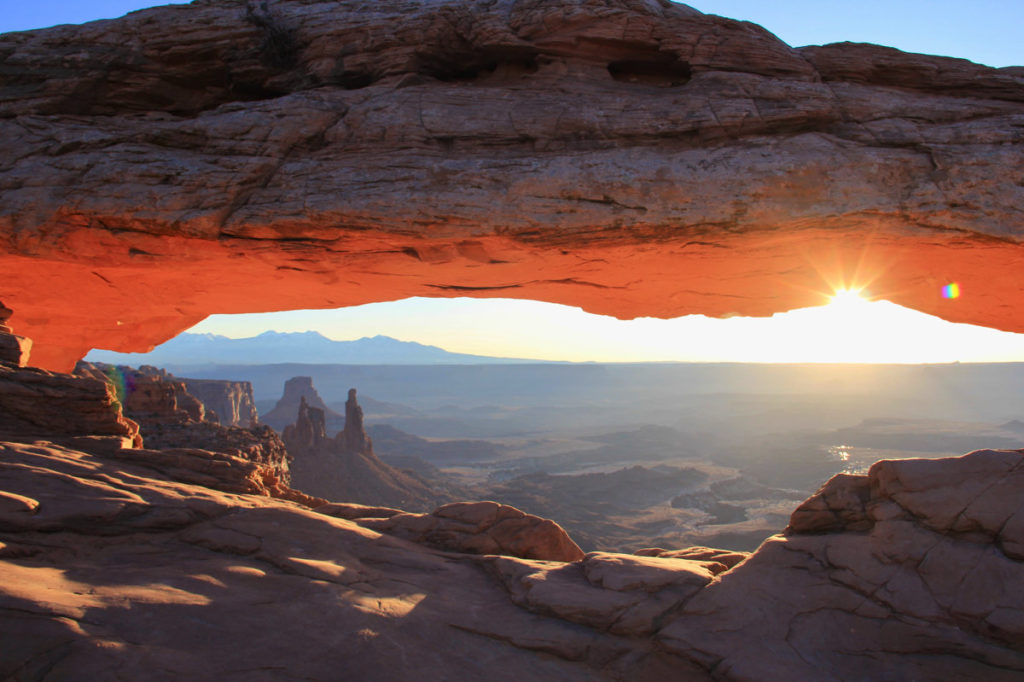
What To Pack For Your Hike To Mesa Arch At Sunrise
- For all of my photographers out there, bring your best camera and a wide angle or ultra-wide angle lens (the low end of the range should be 12 to 16mm for full-frame cameras and 7 to 10mm on a crop sensor camera) if you want to capture the entirety of the arch. Additionally, you may want another lens that will allow you to zoom in for some cropped image compositions.
- Extra, fully-charged camera batteries – keep these warm, ideally in a pocket close to your body, to prevent cold temperatures from zapping their charge.
- A memory card or two with lots of free space.
- Sturdy tripod – not only is this critical if you’re taking pictures on something other than a smartphone and especially if you plan to shoot in manual mode, but, this is also really helpful to stake out your spot in front of Mesa Arch.
- Remote shutter release to avoid camera shake and maximize shooting time. If you don’t have a remote shutter release, use the shortest timer setting your camera has.
- Sturdy hiking shoes or boots – I love my X4 Ultra Salomon Hiking Shoes!
- Ice grips for your shoes if there’s snow or ice
- Headlamp with red light function for stargazing while you wait
- Hat
- Gloves
- Layers of warm clothing
- A warm beverage to enjoy while you wait
- Water – this almost weightless, foldable, BPA-free water bottle is great for hikes.
- Snacks
- Sunscreen (if going after sunrise or exploring more of the park afterward, which you should!)
- Hand/foot warmers depending on the weather
- Either something padded to kneel on OR a lightweight camping chair if you want to be extra comfy while you wait
- Your America The Beautiful National Park Pass and matching ID
Prepare Ahead
Pack your bag the night before so you can get on the road quickly in the morning. Here are some things you want to be sure to do one day in advance:
- Clear your memory card
- Charge your batteries
- Pre-set your camera in your preferred mode and settings – see the next section
- Clean your camera lens(es)
- Clean your camera sensor, if needed
- Ensure your remote shutter release has enough battery and that it’s paired with your camera, as applicable
- Pack your bag
- Lay out your clothes
- Fill up your gas tank
- Know the sunrise time
- Check the hourly weather report. Consider using the Clear Outside app to check cloud cover and humidity.

Camera Settings For Capturing Mesa Arch At Sunrise
The following settings are a starting guideline, but you may need to adjust accordingly as lighting changes.
Manual:
- ISO 100-500
- Aperture F20 or higher (a high F stop will create the sunburst effect when the sun contacts the arch)
- Shutter Speed around 1/100
Aperture-Priority:
- ISO 100-500
- Aperture F20 or higher (a high F stop will create the sunburst effect when the sun contacts the arch)
- Shutter Speed will be set automatically
Smartphone:
- Enable HDR if your phone doesn’t activate HDR automatically
Additional Tips For Your Mesa Arch Sunrise Viewing Experience
- Check the sunrise location ahead of time. Since the position of the sun changes throughout the year, it’s critical that you know exactly where the sun will be rising over the horizon at the time that you visit. This will allow you to know where to position yourself and where to aim your lens. You can use the apps PhotoPills or The Photographer’s Ephemeris for this. Otherwise, your best bet is to position yourself as close to the center of the arch as possible.
- Do not climb on Mesa Arch. Sandstone arch formations are incredibly fragile and putting any weight on them may cause serious damage. Not to mention, you may be punished by the National Park Service.
- Respect others at Mesa Arch. Photographers and nature lovers alike dream of witnessing the sunrise at Mesa Arch, and many visitors to Mesa Arch come specifically to capture the sunrise under the arch in photographs. Thus, be respectful of others’ space and don’t cut in front if you arrive late. Once you’ve taken your pictures, step away to allow someone else the opportunity to get their dream shot. If you want a picture of yourself or your group in front of the arch, wait until after sunrise to avoid getting in other people’s frame.
- Leave no trace. Read about the 7 principles here.
Plan your tours in Moab below through Get Your Guide.
Information About Canyonlands National Park

Where Is Canyonlands National Park
Canyonlands National Park is located in southeastern Utah and is subdivided by the Colorado and Green Rivers into three land districts. The three land districts are Island in the Sky, the Needles, and the Maze.
The Island in the Sky district is the closest district to the nearby town of Moab, Utah, and is also home to the famed Mesa Arch.
Since the three districts are quite spread out, it’s not practical for most visitors to attempt to visit more than one district on the same day since reaching another district requires two to six hours by car.
Thus, if you only have one day to visit Canyonlands, definitely put the Island in the Sky district at the top of your list and plan to be at Mesa Arch for an unforgettable sunrise.
Of course, while you’re in the area, be sure to plan at least one day to visit nearby Arches National Park, located about 5.5 miles from the town of Moab. Prioritize seeing these top arches on your visit.
Dead Horse State Park is also located adjacent to Canyonlands National Park and well worth some of your time. We were short on time, so we combined Canyonlands and Dead Horse State Park in the same day, which worked since we were at Mesa Arch for sunrise. However, you could easily spend more time in both parks if you have time to spare.
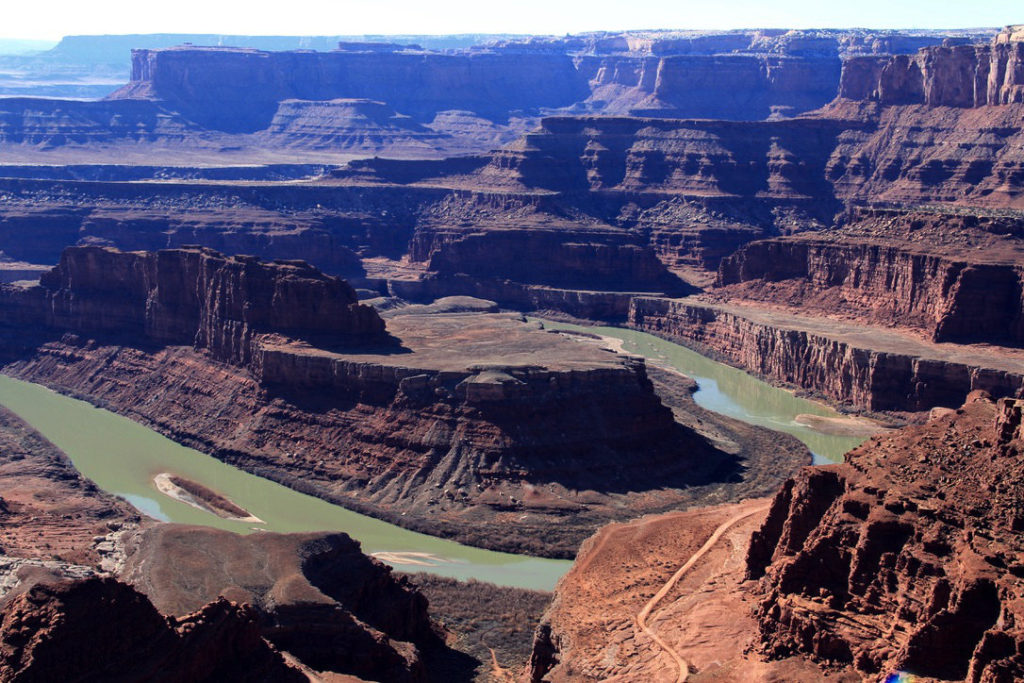
How To Get To Mesa Arch In Canyonlands National Park
The closest airport to Canyonlands is about 4 hours away in Salt Lake City, Utah. The closest town to Canyonlands is Moab, Utah, just shy of an hour from the Mesa Arch trailhead.
To reach the Island in the Sky district that’s home to Mesa Arch, drive approximately 10 miles north of Moab on US-191 N. Turn left onto UT-313 W and drive southwest for an additional 21 miles to the park entrance.
Once you enter the park, you’ll drive straight for an additional 6 miles on Grand View Point Road toward Neck Spring Trail before turning left into the Mesa Arch trailhead parking lot.
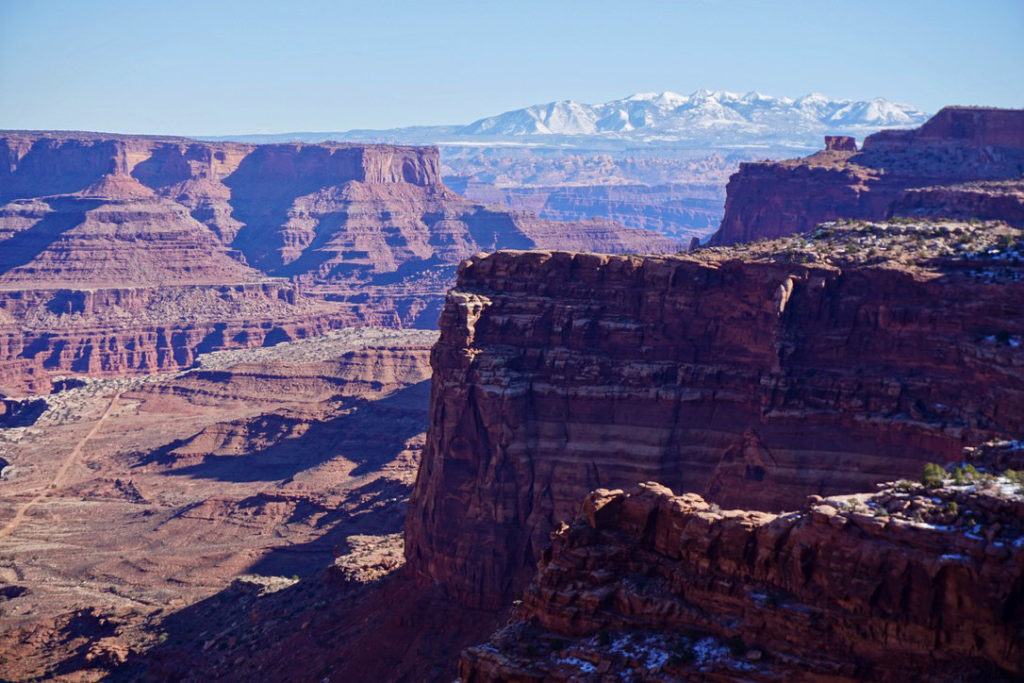
Other Important Canyonlands National Park Information
The park is open 24 hours per day, 365 days per year, however, some facilities may close in the winter. Canyonlands National Park in general is a remote area without many services. Plan to bring everything you might need during your trip.
Tip: Cellular service is limited in the park, and while there may be access to public WiFi in Island in the Sky, outages are possible. Therefore, download a park map for the district(s) you’re going to, and I would also highly recommend downloading offline Google Maps for the surrounding area prior to your trip as a backup. However, cross-reference your GPS directions with the map, as your GPS directions may send you the wrong way, according to the National Park Service.
Timed entry reservations are not required for Canyonlands National Park.
You can enter the park with your America The Beautiful National Park Pass and matching ID, otherwise it costs $30 per vehicle to enter Canyonlands National Park.

Nearby Attractions In Canyonlands
After catching the sunrise at Mesa Arch, plan to spend the rest of the day exploring the Island in the Sky district of Canyonlands. Here are some highlights to consider:
- Green River Overlook – short, handicap-accessible path you do not want to miss
- Grand View Point Overlook & Trail – a 1.8-mile easy hike (about 1.5 hours)
- White Rim Overlook – a 1.8-mile easy hike (about 1.5 hours)
- Murphy Point – a 3.4-mile easy hike (about 2 hours)
- Shafer Canyon – 1-hour scenic drive, unpaved backcountry road requiring high-clearance 4WD vehicles
- Upheaval Dome – a 0.6-mile moderate hike (about 30 minutes)
- Gemini Bridges – accessible with a high-clearance 4WD vehicle
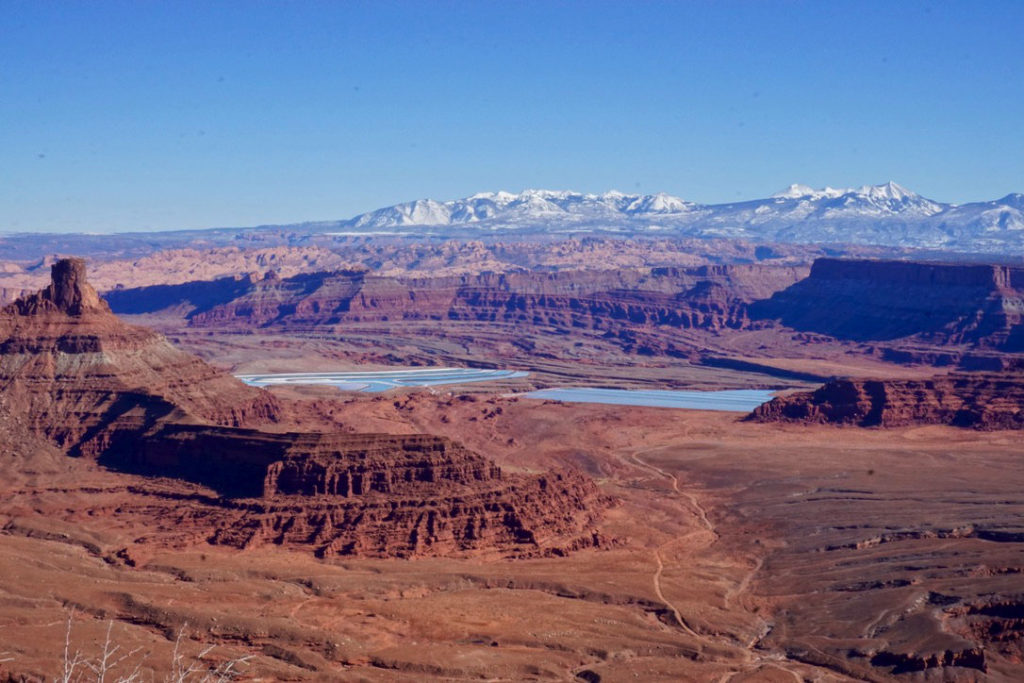
Where To Stay On Your Visit To Canyonlands National Park
Camping Inside Canyonlands National Park
Camping near Mesa Arch will give you an edge over other visitors who will have to drive much farther and wake up much earlier. At a mere 4-minute drive from the Mesa Arch trailhead, Willow Flat is the only campground in the Island of the Sky district, but it only has 12 campsites that are first come, first served.
Camping Outside of Canyonlands National Park
Kayenta Campground in nearby Dead Horse State Park is another option that’s 30 minutes away from the Mesa Arch trailhead. Kayenta Campground is small in size with only 21 campsites.
However, there are 18 nearby campgrounds located on Bureau of Land Management (BLM) property all less than one hour away from the Mesa Arch trailhead, with three of these campgrounds less than 30 minutes away from the trailhead.
The three BLM campgrounds closest to the Mesa Arch trailhead in order from closest to farthest are Cowboy Camp Campground, Horsethief Campground, and Lone Mesa Group Campground.
Additionally, there are 17 commercial campgrounds in the area that offer more options.
Non-camping Accommodation Options
If you’re not planning to camp at one of these three campgrounds, I’d recommend you stay in a hotel in nearby Moab, Utah which is about 38 miles and 50 minutes away from the Mesa Arch Trailhead.
Book your Moab accommodation through Agoda below for the best deals!
In Summary: Is Visiting Mesa Arch At Sunrise Worth It?
Absolutely! Visiting Mesa Arch at sunrise is 100% worth the effort. If witnessing Mesa Arch at sunrise wasn’t already on your bucket list, I hope I’ve convinced you to add it. And, I hope you feel well-equipped to maximize your experience of visiting one of the most famous arches in the US.



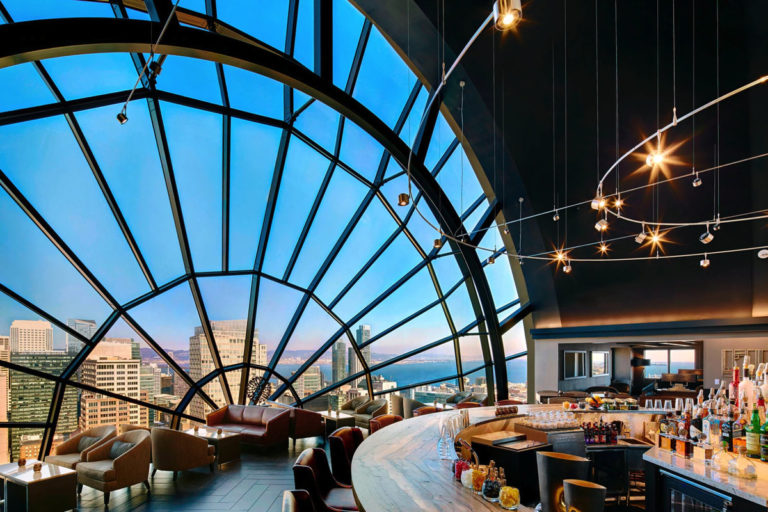
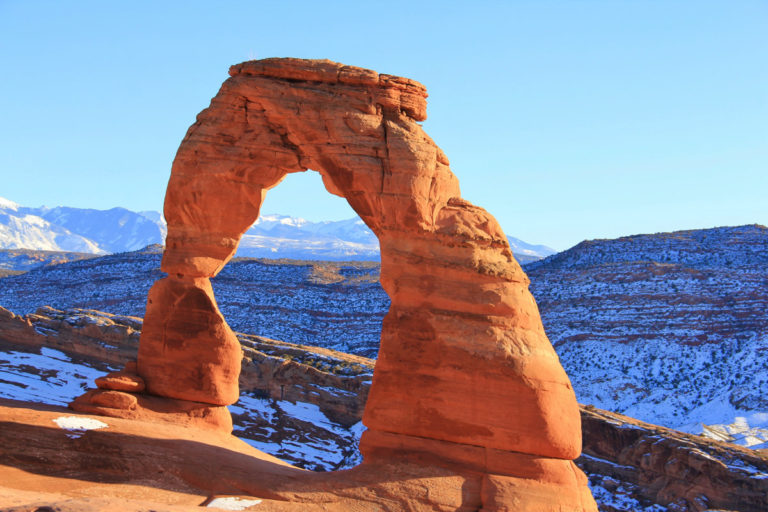



One Comment